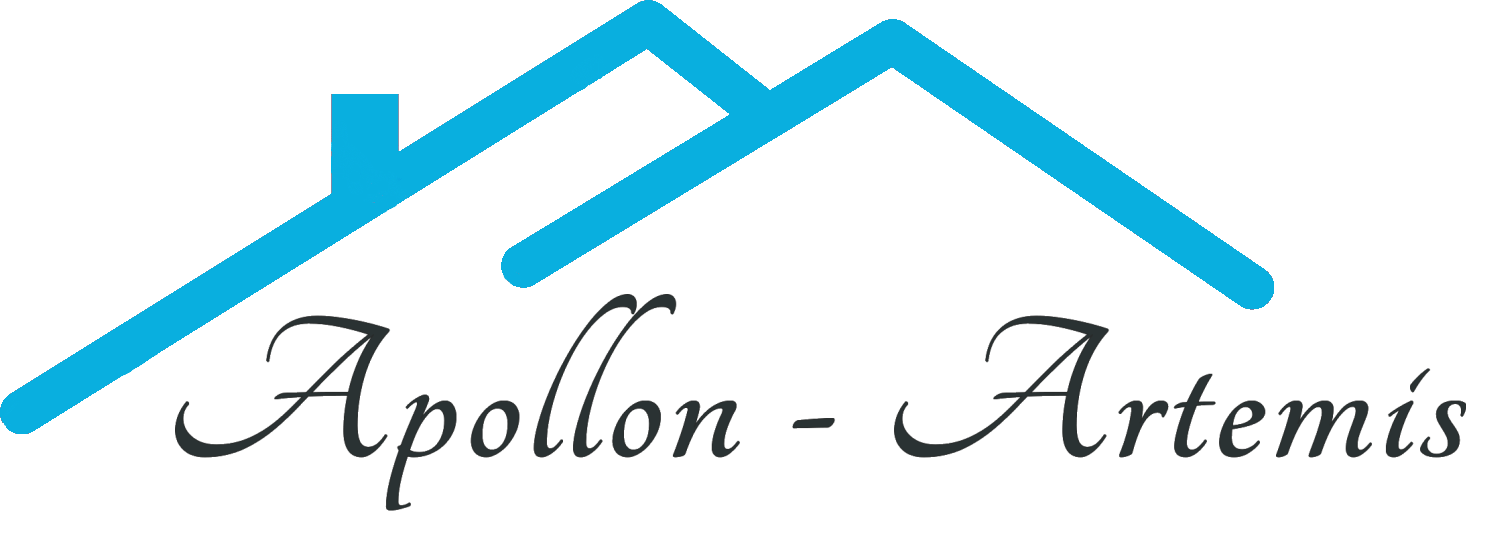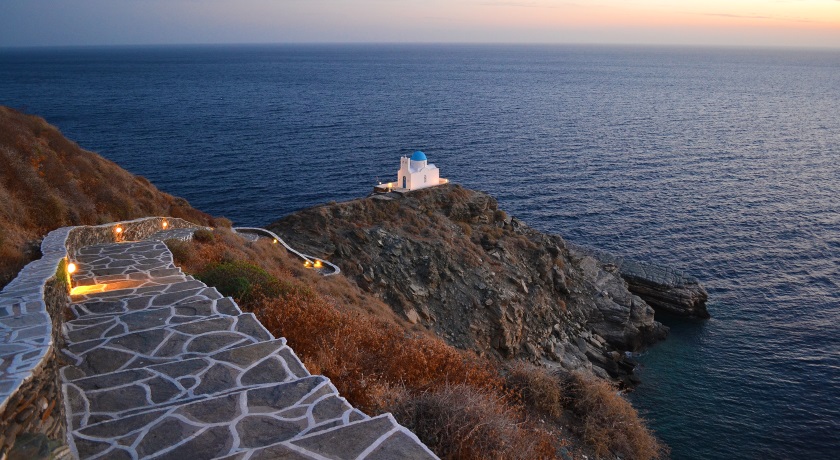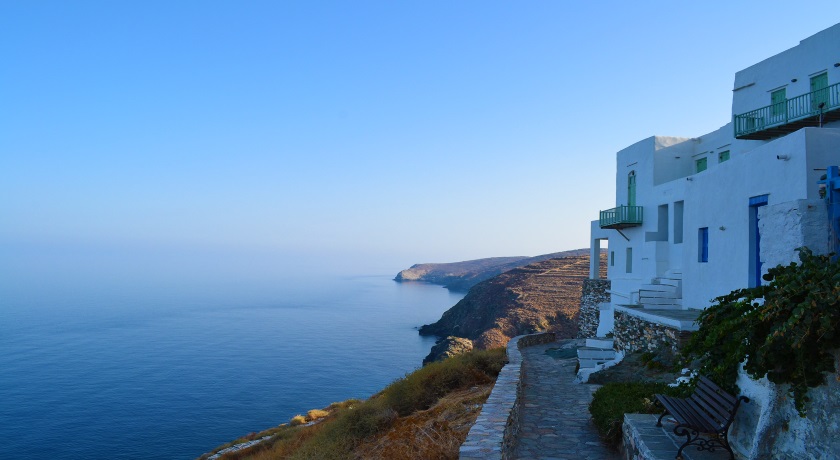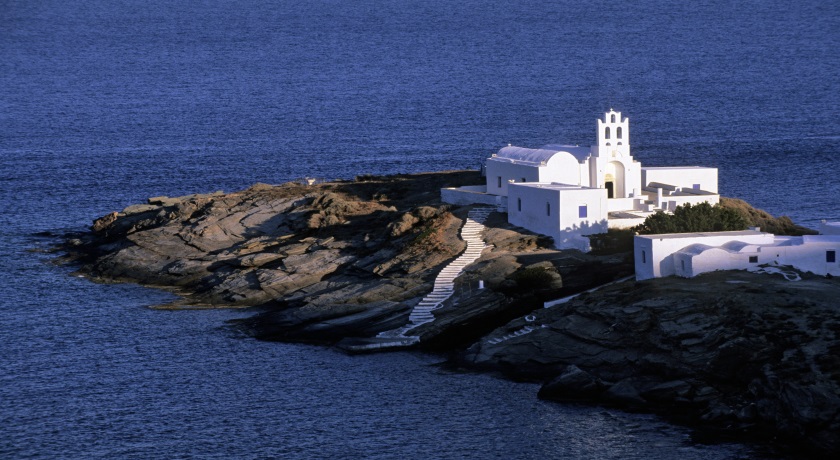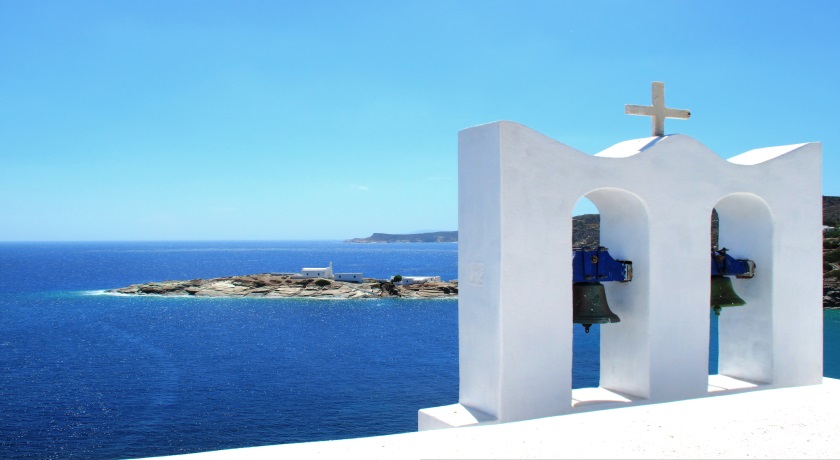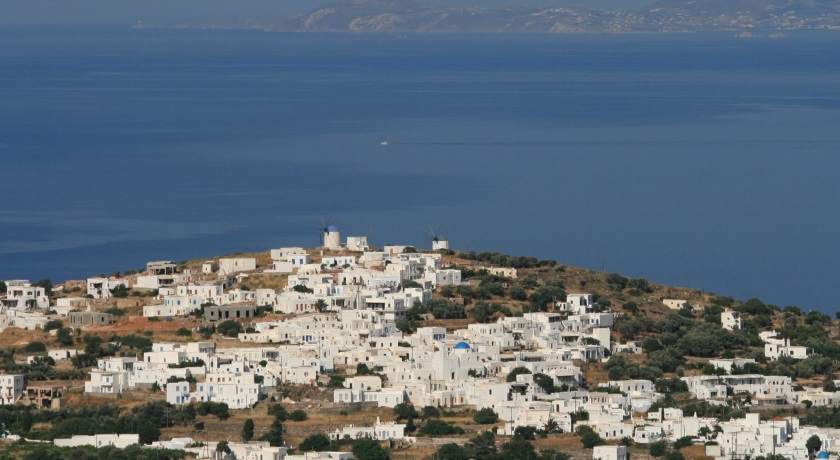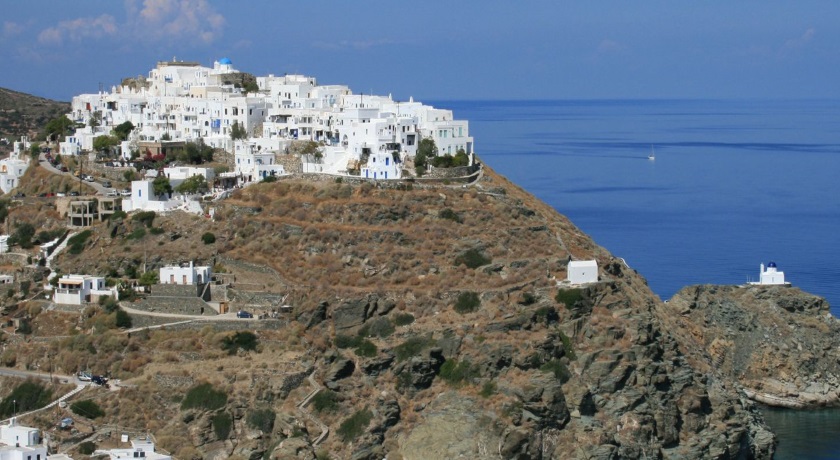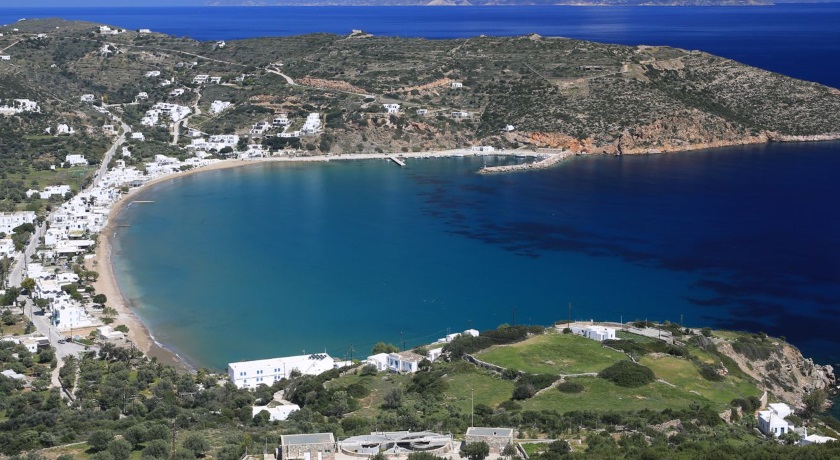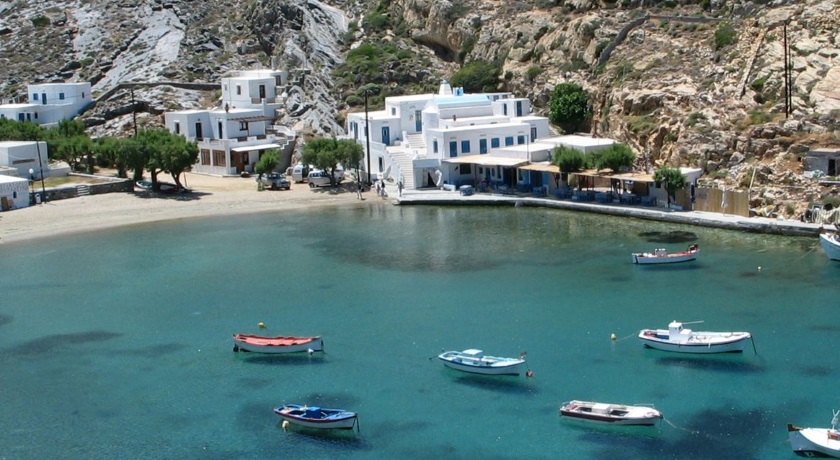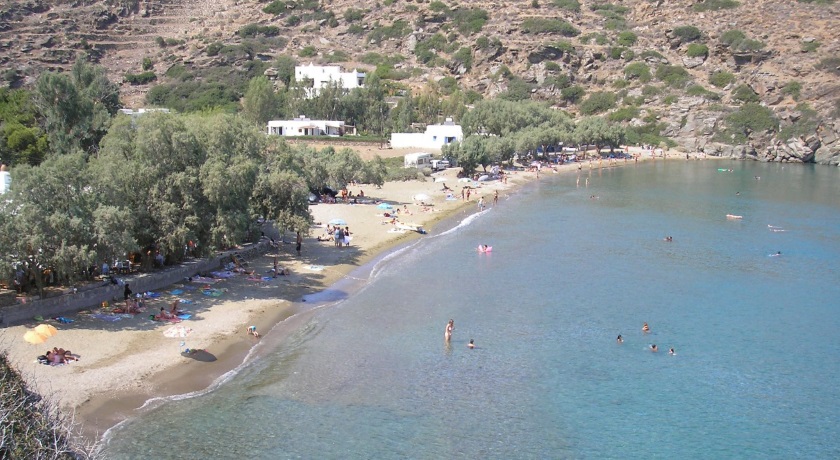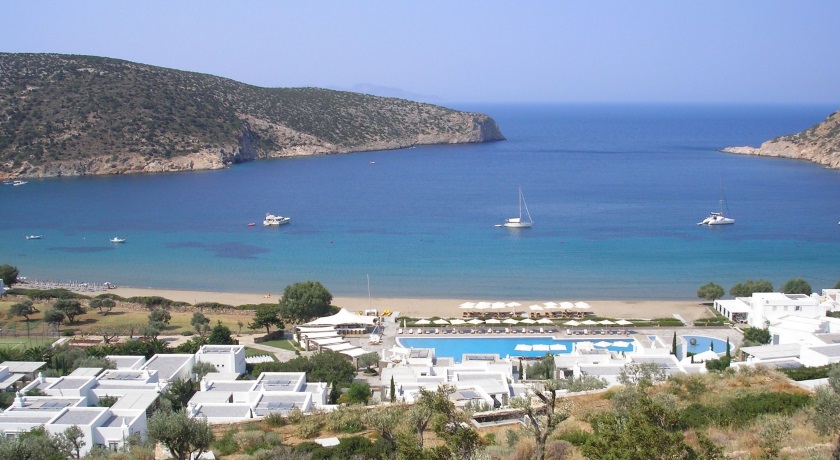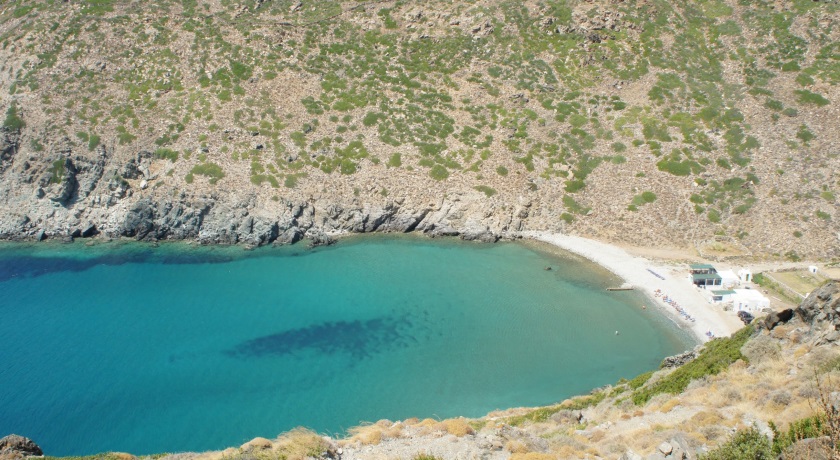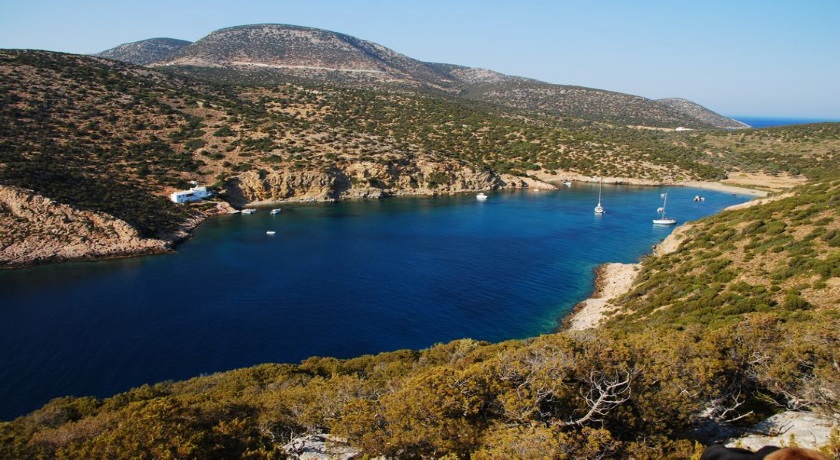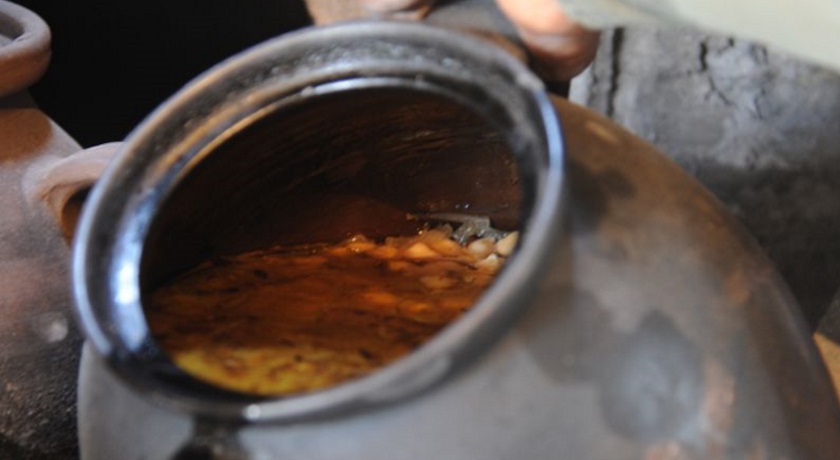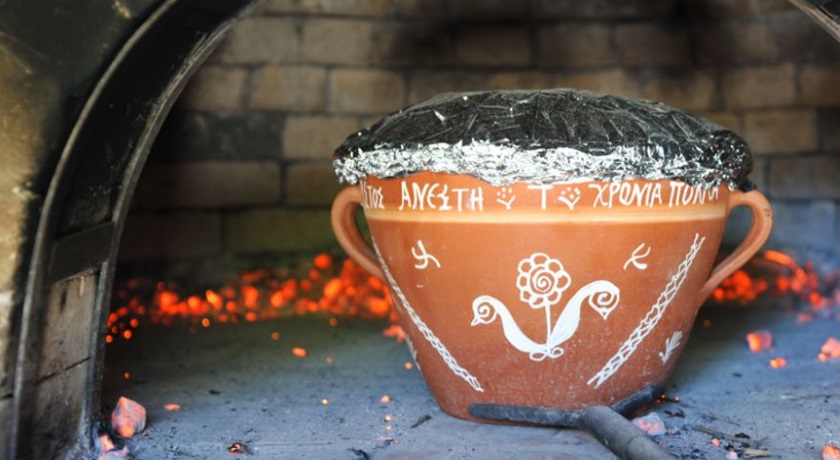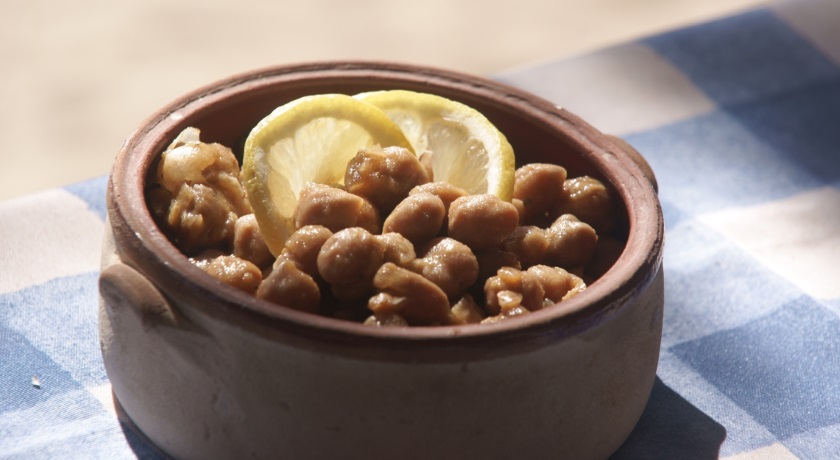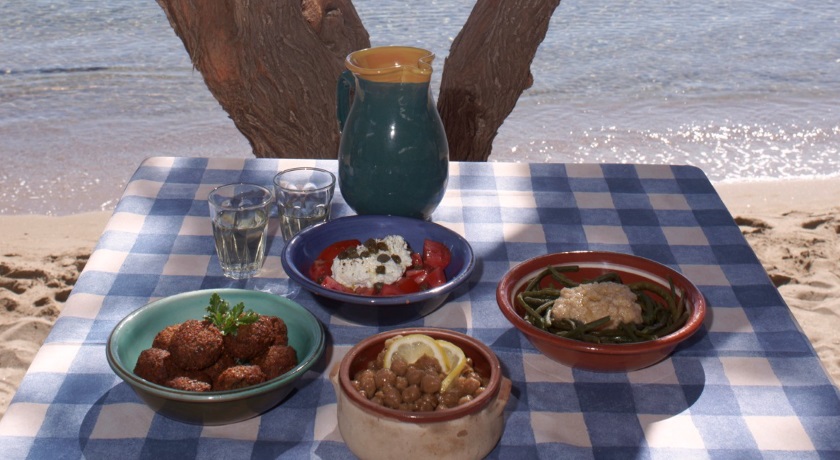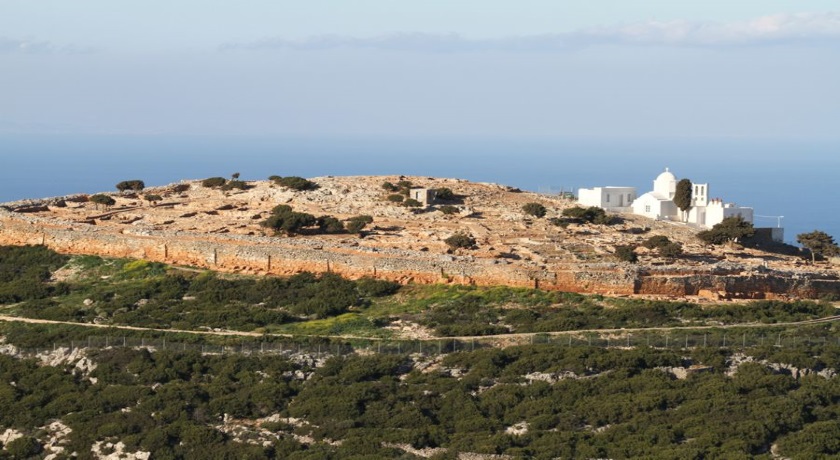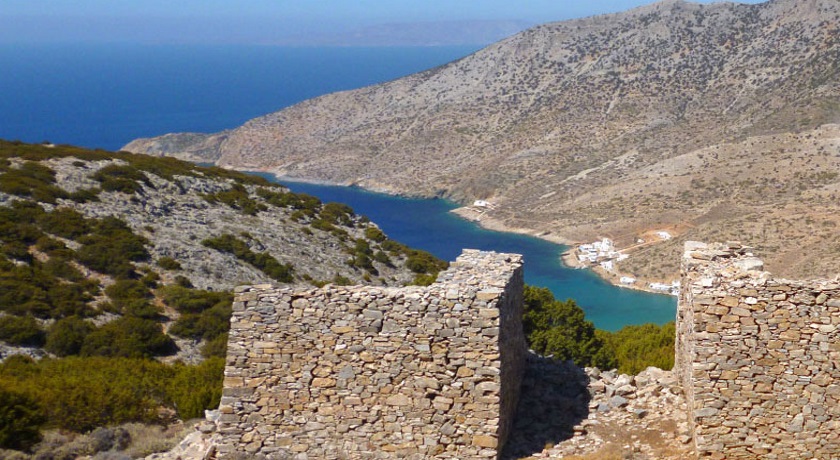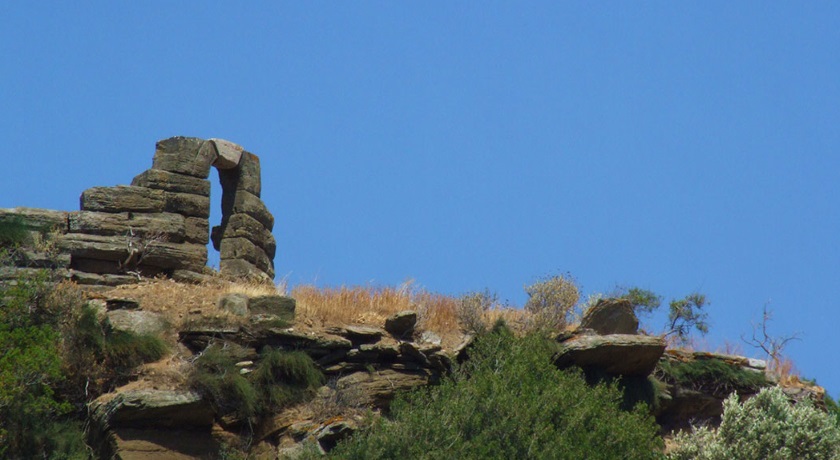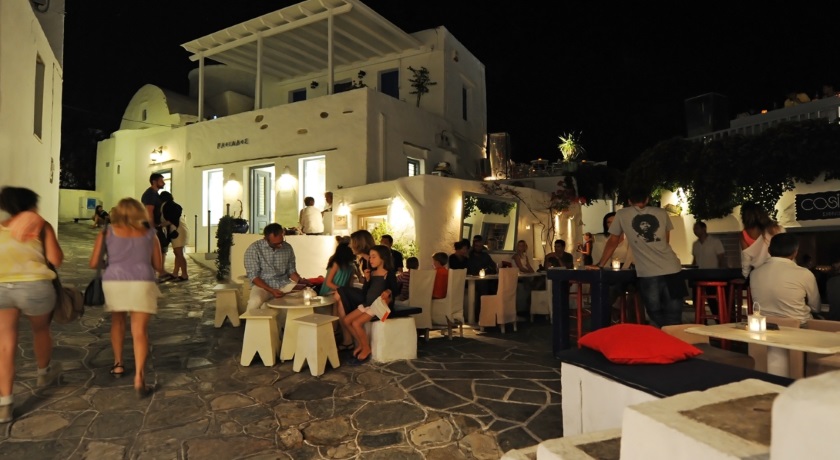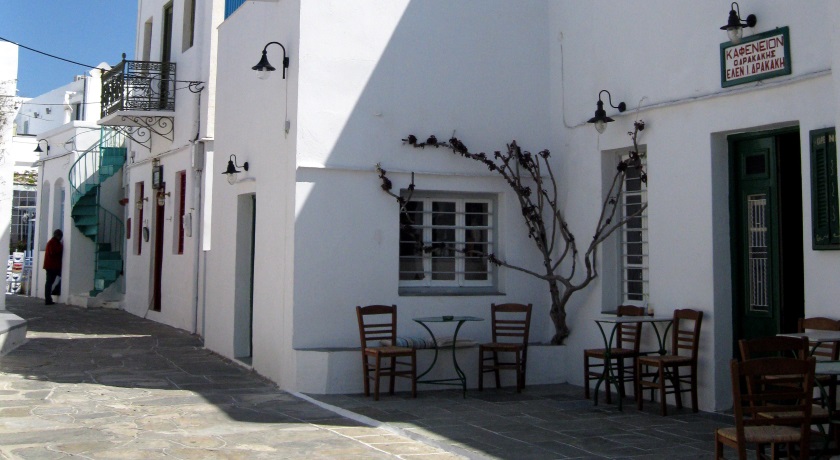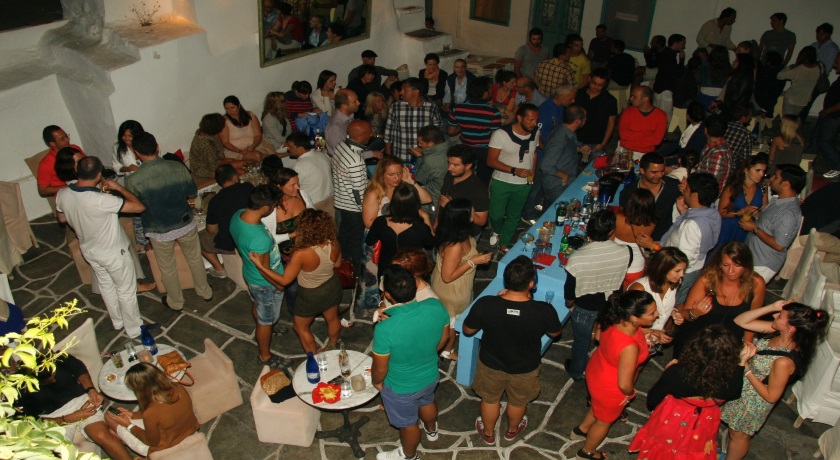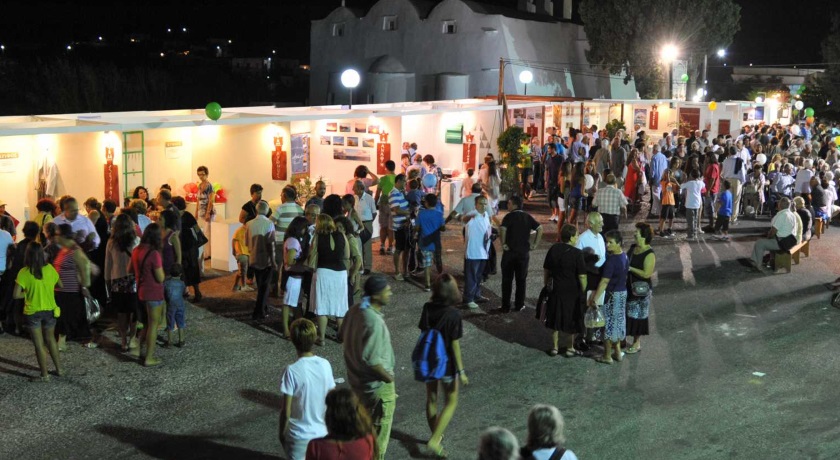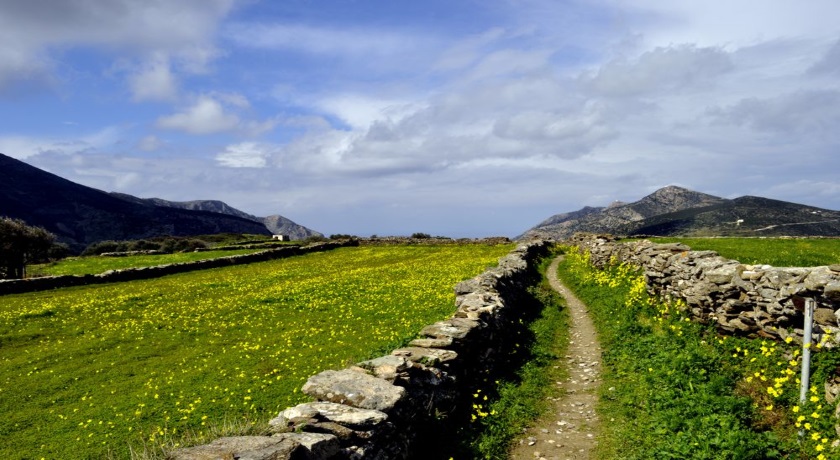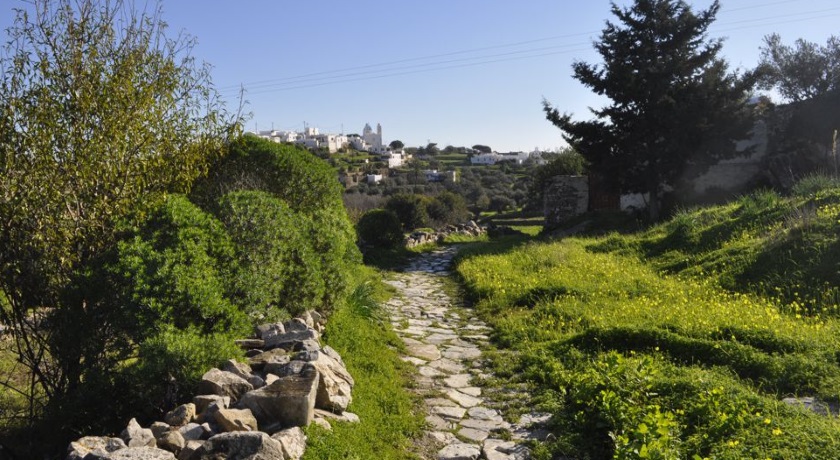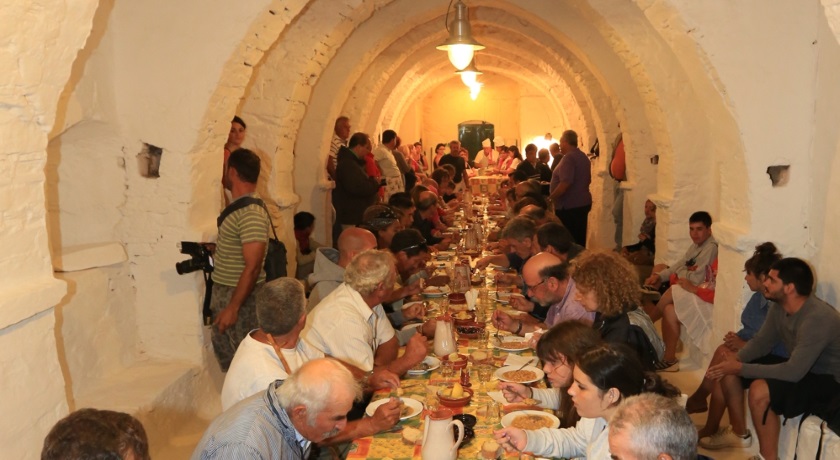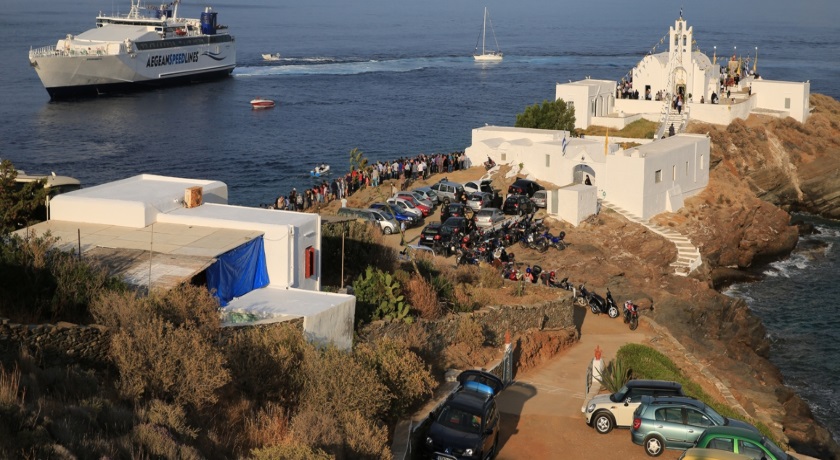Information about Sifnos
Sifnos
The island of Sifnos lies in the Aegean Sea and is a part of the south western Cyclades (situated between Serifos, Kimolos and Paros). It is about 75.6 nautical miles from the Port of Piraeus.
It covers an area of some 73,942 square kilometres, and its coastline is about 705 kilometres long. It is considered to be a medium-sized island. South of the island is the small islet of Kitriani, with its only building, the oldest church of Sifnos, Panagia Kitriani, built sometime between the 10th and 11th century.
The island is traversed by four parallel mountain ranges, the most distinctive peaks being Prophitis Elias (682 m.), in the centre, and Agios Simeon (463 m.) to the north.
According to the last census in 2011, there are 2,570 permanent residents living on the island.
The terrain geomorphology of the island is made up of granite rock formations, clayey sandstone or slate, and limestone, among others. There is also a wealth of mineral deposits, including iron ore, copper, lead, manganese, galena, and magnesium. In ancient times there were gold and silver mines, and the Sifnaion stone quarries, from which the famous fine glass tableware was made, such as the ‘Sifnia’ wine glasses.
The island can be reached by ferryboat throughout the year from Piraeus, Milos, Kimolos, Serifos, Kythnos, Sikinos, Ios, Folegandros, Santorini, Paros and Syros. In summertime the ferry services become more and more frequent and there are additional connections to other destinations, including Mykonos, Naxos and Lavrion. There is also a heliport in the Tholos area of the island, to the north east. The airports nearest to the island are those of Paros, Milos and Syros. The nearest international airports are on the islands of Santorini and Mykonos, but most overseas visitors arrive via the Athens International Airport ‘Eleftherios Venizelos’.
Villages
Apollonia
Apollonia is the capital and administrative centre, located in the middle of the island. The name Apollonia derives from the worship of the god Apollo on the island in antiquity. It is also referred to as Stavri, probably after the main crossroads in the area (‘stavrodromos’ being the Greek word for crossroads), which leads north to Artemonas, east to Kato Petali and Kastro, west to Kamares, and south to Platy Gialos, Faros, etc.). Another explanation of the name Stavri is that it comes from the church of the Holy Cross, in the centre of the village. In Apollonia (which together with the other central settlements of the island has been declared a traditional and therefore protected village settlement) there are banks, a police station, a health clinic, post office, the island’s municipal building, pharmacies, a tourist office, restaurants, rooms to let, apartments and hotels, bars and restaurants. Outside the post office there is a taxi rank, as well as a bus stop for Kamares. At the main junction there are bus stops for all the other villages and beaches of the island. Along the main picturesque path through Apollonia leading to Katavati (known as ‘the Alley’) there are interesting old churches, shops and places to eat or stop for a drink. On summer evenings the place is buzzing with life. The Folklore Museum of Sifnos, run by the Sifnos Association, is to be found Apollonia’s main square (Plateia Iroon or ‘Heroes Square’). It houses a variety of exhibits showing the daily life and occupations of the people of Sifnos in bygone days, and includes traditional costumes, Sifnian pottery, and historically important publications. In Rambagas Square (off the main path) there is a bust of the Sifnos publisher, militant journalist, and satirical poet Kleanthis Triantafyllou, who was born in Sifnos in 1850, and later published the progressive political satirical magazine "Rambagas" in Athens. The magazine was the forerunner to the New Athenian School, and was the source of Kleanthis Triantafyllou’s pen name, Rambagas. It also prompted strong reactions, and twice led him to imprisonment. Kleanthis Triantafyllou, having fallen victim to an assassination attempt, and suffering in his later years from serious mental disorder, committed suicide in 1889.
Artemonas
Artemonas is one mile northwest of Apollonia, and with its labyrinthine streets and alleyways, is the largest village on the island. Its name comes from the worship of the goddess Artemis on the island in antiquity. There was once a temple to Artemis on the site of today's parish church in the village, Panagia Koghis. Artemonas is the terminus for all of the island’s bus routes. There are notable old churches, traditional bakeries and pastry shops, restaurants, rooms to let, apartments and hotels, and traditional pottery workshops. Next door to the ‘Panagia tou Bali’ church is the ‘Ioannis Atsonios’ folk arts and crafts exhibit entitled ‘Us at Home in the Old Days’, which is opened to the public by the Cultural Association of Sifnos during the summer months. The aristocratic aspect of Artemonas is the result of the economic prosperity of the village half a century ago, reflected in wonderful neoclassical buildings and homes with courtyards full of flowers, mainly found along the village’s central path. The views from many parts of the village are stunning. From the area of the windmills (in the east of town) known as ‘Bella Vista’ (or Kallithea in Greek), one can admire the views of the village of Kastrou from above, look out across the open sea, and also see many of the other Cycladic islands. Artemonas is the birthplace of Nikolaos Chrisogelos, the great teacher of the nation, a fighter for independence, and the first Minister of Education of the modern Greek state, who was a pioneer of peer method teaching and primary education. His bust can be seen in the square next to the Artemonas Local Community offices and the Citizen’s Advice Service Centre. Artemonas is also the birthplace of the distinguished philologist, poet and translator, Ioannis Gryparis, who served as the first director of the National Theatre and was awarded the highest honours in Arts and Letters by the Academy of Athens. Outside his home on the street named after him in Artemonas there are commemorative marble plaques from Sifnian Association and the Association of Greek Writers. A statue of the poet was erected in the courtyard of the Sifnos Junior School on August 19, 2012 by the Cultural Association of Sifnos, the work of the sculptor Kostas Klouvatou. Every September the Cultural Association of Sifnos organises a three-day Festival of Cycladic Gastronomy in honour of Nikolaos Tselementes, the chef and cookery book writer, with the participation of chefs and cooks, musicians and dancers from many of the Cyclades islands, with demonstrations of local recipes, culinary competitions and many other side events and exhibitions.
Vathi
Vathi is located in the west, 10 km from the capital, Apollonia. At "Punta tou Polemikou", the northern end of the bay, archaeological excavations have brought to light prehistoric settlements and tombs. In the more recent past, until the Second World War, Vathi was a village of potters. It is the most beautiful and largest of the sandy beaches on the island, with a rare protected species of ‘sand lilies’ blooming around the middle of August. Here there are rooms to let, restaurants, grocery stores, cafés and pottery workshops. Many of the hiking trails through the NATURA protected areas start at Vathi, as well as those leading to Fikiada and Platy Gialos to the east. On the beach there is the beautiful church of Taxiarches (the Archangels) (16th century), which holds a festival three times a year (July, September and November).
Kamares
Kamares is about 5 km away from Apollonia. It is the main port facility of the island and the largest coastal settlement. The majority of the rooms to let, hotels, and restaurants are to be found in Kamares, as well as a number of grocery stores, shops, bakeries, a private camp site, tourist offices, numerous cafés, pâtisseries, and pottery workshops, the Municipal Information Office, and the Port Authority. On the opposite side to Kamares, the ‘Pera Panta’ (the ‘Forever Beyond’, is the area of Agia Marina, named for the church on the side of the hill. In Agia Marina too, there are also rooms to let, hotels, grocery stores, cafés and restaurants. Between the two areas lies the beach of Kamares, one of the most beautiful pristine sandy beaches, bordered by native vegetation, reed beds, coastal lagoons and sand dunes, where rare 'sand lilies' bloom in August. The beach receives awards every year from the FEE, with the blue flag of the European Union indicating its compliance with 32 strict criteria of the programme (cleanliness, organisation, swimming water quality, safety, life guard facilities, first aid, services, facilities, etc.) A number of hiking routes start out from Kamares, including those leading to the Nymfon church at Korakies, the Mavri Spilia (the Black Cave), the site of the old mining area, and the NATURA protected site. Another trail of greater difficulty leads to the north of the chapel of Agia Anna in Pera Panta, heading towards Agios Simeon. Another hiking route leads east to Apollonia and the central inland village settlements.
Kastro
Kastro is the old capital of the island and the seat of the Archdiocese of Sifnos (6th-19th century). It is one of the most picturesque, beautiful, and the most important of the villages of the island from an archaeological standpoint. This is the ancient ‘city’ referred to by Herodotus, which flourished in the 6th century BC, with a temple and a theatre dedicated to Dionysus, and grand marble public buildings. It has been continuously inhabited from prehistoric times (first settlements on the hill were in the 3rd millennium BC) to the present day. The village's name comes from the fortress-like 'castle' formed by its buildings. The settlement has an ellipsoidal form, following the terrain, and has a defensive aspect, preserving unchanged its medieval (Venetian) fortified formation. Two defensive rings of buildings can be observed, each built close by the next, with mansion houses for the richer inhabitants in the inner ring where they had greater protection, and the houses of the poor in the outer ring. The ruins of the ancient acropolis stand tall at the top of the hill (6th century BC), ancient columns are set in the walls of newer buildings, and there are Roman sarcophagi to be seen in the alleys. There are the six ‘lodges’ (gateways at the entrances to the village), 16th and 17th century chapels with decorated floors and many other details making Kastro a living open-air museum. At the highest point of the village is the ‘katholikon’ cathedral church, and nearby stands a column bearing an inscription by Giannoulis Da Corogna dating back to the 14th century. The Sifnos Archaeological Museum can be found in centre of the village, with exhibits (mainly sculptures and coins) from the prehistoric to the Roman era. East of Kastro is the picturesque chapel of the ‘Eptamartiron’ (Seven Witnesses) standing on the rocks, where the panoramic view of the sea is breathtaking. Further to the north, the ancient path leads to Panagia Poulati, a designated area of outstanding natural beauty. Poulati, like Eptamartyron, is an ideal spot for diving off the rocks. West of the village, at the foot of Kastro hill, there is a small pebbled beach (the island’s ancient harbour), known by the name Gialos or ‘Seralia’ from the word seraglio, meaning palaces, that were once to be found there. Kastro opened the first known school on the island (in the early 17th century), and later established the famous School of Panagia Tafou (the Holy Sepulchre) also known as the ‘Seminary of the Archipelago’ (from the mid-17th century). On the same site today stand the twin churches of Agios Stefanos and Agios Ioannis Kalyvitis. Great teachers and priests were graduates of the seminary, including Nikolaos Chrysogelos (later a teacher at the same school and the first Minister of Education of the Modern Greek state), as well as forty-eight bishops and two ecumenical patriarchs. Kastro is the birthplace of the university professor and academic Georgios Maridakis (his marble bust can be seen in the courtyard outside the Theologos chapel). It is also the birthplace of the former President of the Supreme Court of Greece, Antonis Zilimonos. Kastro today offers a few rooms to let, restaurants, bakeries, cafés and bars, and the beach front (Seralia) has a few fish tavernas.
Platis Gialos
Platis Gialos is one of the largest sandy beaches of the island and is the most popular choice of Greek visitors. The beach of Platy Gialos receives awards every year from the FEE, with the blue flag of the European Union indicating its compliance with 32 strict criteria of the programme (cleanliness, organisation, swimming water quality, safety, life guard facilities, first aid, services, facilities, etc.) On the left side of the bay there is a fishing boat refuge that also provides services to yachts. In the middle of the village, next to Alexandros Vernikos Square, there is a small open air theatre. Also of interest is the church of Agia Sofia on the right hand side of the main road. Local attractions include the White Tower 1.5 km northeast of the beach, one of the 77 ancient beacon towers (‘fryktories’) of the island and the best preserved. In Platy Gialos there are rooms to let, hotels, restaurants, grocery stores, a tourist office, cafés, and pottery workshops. Many hiking trails start from the village, heading towards Fikiada, Vathi, and the other central village settlements. Opposite the beach of Platy Gialos is the uninhabited islet of Kitriani, with its solitary building, the church of the same name, Panagia Kitriani, the oldest church of Sifnos (10th-11th century).
Chrysopigi
Ten kilometers from Apollonia, just before Platy Gialos, is the most famous spot on the island, Chrysopigi. On the peninsula here is Monastery of Panagia of Chrysopigi (Virgin Mary of Chrysopigi)(1523), patron and protector of the island, celebrated with a festival on the eve of Analipsi (Ascension Day). The festival of Chrysopigi follows a special ritual that includes procession of the icon around the villages and an all-night vigil. It attracts hundreds of pilgrims every year. The rocks at Chrysopigi are a favourite jumping off point for many swimmers. East of the church is the sandy beach of ‘Apokoftou’ with its crystal-clear azure waters. The only buildings are the two restaurants right on the sands. From there, begins a cobbled pathway leading to the beach of Glyfos in Faros. West of the church is Saoures, a small secluded pebble beach. Local attractions include the White Tower, located near the crossroads between Platy Gialos and Chrysopigi, which is the most famous of the 77 ancient towers on the island and the best preserved. In the general area of Chrysopigi there is a grocer’s and limited tourist accommodation.
Beaches
Kamares
Kamares is about 5 km away from Apollonia. It is the main port facility of the island and the largest coastal settlement. The majority of the rooms to let, hotels, and restaurants are to be found in Kamares, as well as a number of grocery stores, shops, bakeries, a private camp site, tourist offices, numerous cafés, pâtisseries, and pottery workshops, the Municipal Information Office, and the Port Authority. On the opposite side to Kamares, the ‘Pera Panta’ (the ‘Forever Beyond’, is the area of Agia Marina, named for the church on the side of the hill. In Agia Marina too, there are also rooms to let, hotels, grocery stores, cafés and restaurants. Between the two areas lies the beach of Kamares, one of the most beautiful pristine sandy beaches, bordered by native vegetation, reed beds, coastal lagoons and sand dunes, where rare 'sand lilies' bloom in August. The beach receives awards every year from the FEE, with the blue flag of the European Union indicating its compliance with 32 strict criteria of the programme (cleanliness, organisation, swimming water quality, safety, life guard facilities, first aid, services, facilities, etc.) A number of hiking routes start out from Kamares, including those leading to the Nymfon church at Korakies, the Mavri Spilia (the Black Cave), the site of the old mining area, and the NATURA protected site. Another trail of greater difficulty leads to the north of the chapel of Agia Anna in Pera Panta, heading towards Agios Simeon. Another hiking route leads east to Apollonia and the central inland village settlements.
Platy Gialos
Platis Gialos is one of the largest sandy beaches of the island and is the most popular choice of Greek visitors. The beach of Platy Gialos receives awards every year from the FEE, with the blue flag of the European Union indicating its compliance with 32 strict criteria of the programme (cleanliness, organisation, swimming water quality, safety, life guard facilities, first aid, services, facilities, etc.) On the left side of the bay there is a fishing boat refuge that also provides services to yachts. In the middle of the village, next to Alexandros Vernikos Square, there is a small open air theatre. Also of interest is the church of Agia Sofia on the right hand side of the main road. Local attractions include the White Tower 1.5 km northeast of the beach, one of the 77 ancient beacon towers (‘fryktories’) of the island and the best preserved. In Platy Gialos there are rooms to let, hotels, restaurants, grocery stores, a tourist office, cafés, and pottery workshops. Many hiking trails start from the village, heading towards Fikiada, Vathi, and the other central village settlements. Opposite the beach of Platy Gialos is the uninhabited islet of Kitriani, with its solitary building, the church of the same name, Panagia Kitriani, the oldest church of Sifnos (10th-11th century).
Vathi
Vathi is located in the west, 10 km from the capital, Apollonia. At "Punta tou Polemikou", the northern end of the bay, archaeological excavations have brought to light prehistoric settlements and tombs. In the more recent past, until the Second World War, Vathi was a village of potters. It is the most beautiful and largest of the sandy beaches on the island, with a rare protected species of ‘sand lilies’ blooming around the middle of August. Here there are rooms to let, restaurants, grocery stores, cafés and pottery workshops. Many of the hiking trails through the NATURA protected areas start at Vathi, as well as those leading to Fikiada and Platy Gialos to the east. On the beach there is the beautiful church of Taxiarches (the Archangels) (16th century), which holds a festival three times a year (July, September and November).
Faros
Faros is a sheltered harbour and fishing village 7 km from Apollonia. It was the island’s main port until 1883 and is named after the ancient tower (Faros being the Greek word for lighthouse) on the beach (where the footpath from Faros to Glyfo begins today). On the waterfront at Faros is a small stone theatre which hosts a variety of cultural events during the summer season. In Faros there are three small sandy beaches: The central beach, where the asphalt road ends, has spectacular views of Chrisopigi. It also has a number of restaurants, cafés, bars and a grocery store. The beach at Glyfou is so named for the well of brackish water which has been there since ancient times, and is still there today, to the right of Faros beach. From Glyfou begins the beautiful paved footpath (illuminated at night) leading to the beaches of Apokoftou and Chrysopigi. To the right of the beach, the steps to leading to the ancient mines and the remains of the old ore-loading facilities are visible. Lastly, there is Fasolou, to the left of Faros beach, where there is a restaurant and rooms to let. The Monastery of Stavros (the Cross) in Faros is also to be found at Fasolou. Hiking trails starting at Faros lead to the Acropolis on the hill of Agios Andreas and Kastro.
Chrysopigi
Ten kilometers from Apollonia, just before Platy Gialos, is the most famous spot on the island, Chrysopigi. On the peninsula here is Monastery of Panagia of Chrysopigi (Virgin Mary of Chrysopigi)(1523), patron and protector of the island, celebrated with a festival on the eve of Analipsi (Ascension Day). The festival of Chrysopigi follows a special ritual that includes procession of the icon around the villages and an all-night vigil. It attracts hundreds of pilgrims every year. The rocks at Chrysopigi are a favourite jumping off point for many swimmers. East of the church is the sandy beach of ‘Apokoftou’ with its crystal-clear azure waters. The only buildings are the two restaurants right on the sands. From there, begins a cobbled pathway leading to the beach of Glyfos in Faros. West of the church is Saoures, a small secluded pebble beach. Local attractions include the White Tower, located near the crossroads between Platy Gialos and Chrysopigi, which is the most famous of the 77 ancient towers on the island and the best preserved. In the general area of Chrysopigi there is a grocer’s and limited tourist accommodation.
Herronisos
Herronissos is the northernmost beach of the island and is 15 km from Apollonia. It is a picturesque fishing village with a small sandy beach. Here there are tavernas, a small grocery store, a few rooms to let and a traditional pottery workshop. The northernmost buildings on the island are situated on the hill above the village. They are the Church of Agios Georgios and the remains of one of the ancient beacon towers. On the route to Herronisos from here are the villages of Troullaki and Diavroucha and some pottery workshops.
Vroulidia
This is a small pebble beach, 14 km from Apollonia and one kilometre outside Herronisos. There are two café restaurants which provide umbrellas and sun beds for bathers.
Fykiada
Fykiada is a small sandy beach between Platy Gialou and the bay of Vathi. Near the beach is the chapel of Agios Georgios. Behind the chapel is one of the oldest olive trees on the island and there are traces of the old cart road.
Cuisine
The island, birthplace of Nicholas Tselementes and a number of other master chefs, has a rich variety of gastronomic traditions. At Christmas the delicious smells of baking drift from the houses. The most popular in Sifnos at this time of year are ‘foinikia’ (elsewhere in Greece known as ‘melomakarona’ - honey syrup cookies) and ‘avgokalamara’ (elsewhere known as ‘diples’ - deep fried strips of dough rolled and dipped in honey syrup). During winter traditional ‘siglino’ (cured smoked pork), ‘pykti’ (pork jelly) is still prepared today. A little later in the year, for Carnival, next in line are dairy desserts, rice pudding, cream desserts, goat and sheep's milk yoghurt, which is fresh produced in large quantities at this time. And it wouldn’t be Easter in Sifnos without the smell of roasting ‘mastelo’ (lamb or lamb cooked in a clay pot, also called a ‘matselo’, with red wine and dill baked in a wood-burning oven), without the ‘poulia tis Lambris’ (the ‘birds of Easter’, a kind of brioche), honey pies, a sweet prepared with Sifnian boiled ‘athotyros’ (fresh soft white cheese) and local thyme honey. The joys of marriage ceremonies are celebrated by preparation of Sifnian diamond-shaped ‘pasteli’ (honey and sesame toffees) and pan or oven-cooked marzipan (with or without sugar). The traditional festivals of the island are accompanied by communal meals at long tables, reminiscent of meals in ancient times or early Christian ‘Agape’ or Love feasts. They involve the serving of traditional ‘revithada’ (chickpea soup) and braised lamb or goat ‘kokkinisto’ cooked in ‘red’ tomato sauce in special large metal pots or cauldrons and served with pasta, or during Lent, fried cod with garlic sauce and salad. On Sundays, the main dish is the chickpea soup, baked in clay pots (‘skepastaria’) for several hours overnight, in wood-burning ovens fed with vine twigs. Other dishes never absent from the Sifnos meal are chickpea patties, caper salad (stewed dry caper), kalasouna (pies filled with wild greens and rice), ‘manoura’ (yellow hard spicy cheese matured in ‘gyli’ (red wine dregs)), and, depending on the season, ‘chyrovoskoi’ (wild greens), ‘myzithra’ cheese (fresh goat cheese with a slightly sour taste, ideal as an addition to Greek (‘village’) salad), or string beans with garlic puree. Also popular are dried figs, ‘loli’ (a sweet dessert made with red pumpkin), syrupy ‘spoon’ sweets and liqueurs made with fruit that grow abundantly in Sifnos, and infusions made from the rich variety of plants and herbs growing wild on the island, including sage and chamomile. Local Sifnos sweet treats can be found in the traditional bakeries and patisseries, in the form of aniseed biscuits, butter biscuits, boiled and baked almond marzipan, honey and sesame ‘pasteli’ bars, Greek ‘loukoumia’ (‘Turkish delight’), ‘bourekakia’ (honey nut phyllo pastry rolls), and syrup ‘spoon’ sweets.
Culture
With a history that goes back centuries, the culture of the island until today is an element of promotion of the island worldwide. From very early Cycladic period (3000 BC), the island has experienced tremendous economic and cultural development because of its geopolitical wealth. The ancient mines were rich in silver ore, lead, gold and iron. That is the reason why art pottery in Sifnos was flourished. Until today, the pottery is an integral part of its culture. The entire ancient culture of the island and its connection with the Mycenaean is revealed through archaeological sites. At the museums of the island, the traveler may be acquainted with the particular culture, vibrant religious tradition, and the manners and its customs. The most significant image of the religious culture of the island is reflected in the hundreds of churches. Great monasteries and picturesque chapels are built in wild landscapes "cutting" the breath of the visitor. Closely connected with churches are the festivals. Up to today, is one of the most important and characteristic traditional "habits" of locals. The island bears the title of "island of the poets." Not without reason, since the attractions of civilization one encounters busts of important men and women from Sifnos who excelled among others, in the field of literature, arts and history.
Enterntainment
After the sun goes down the choices are many and varied. There are tavernas serving local specialty dishes, fish tavernas with fresh fish and seafood, a wide variety of restaurants, ‘mezedopoleia’ (small bistros serving appetisers or snacks and drinks) and bars that stay open till the early hours, often with live music. The star of the island’s nightlife is the famous ‘Steno’ (narrow alleyway) in Apollonia, for all forms of entertainment until the small hours. There are more relaxed bars with a less frenetic atmosphere in Kamares, Platy Gialos, Faros and Katro. Evening is the time of day when most of the island’s cultural events are held, particularly during the summer. They include concerts, evenings of traditional local dance and music, theatrical performances, book launches, and important art exhibitions, including exhibits on loan from the National Gallery and the Benaki Museum. The festivals, the basic entertainment of the local people in earlier years, are still a particularity of the island today that is definitely worth experiencing. For those whose idea of entertainment is a quiet romantic stroll, the island does not disappoint. The inland villages with their cobbled streets, the castle fortifications in Kastro that are illuminated at night, or the many secluded beaches and rocky outcrops of the coast will leave the best of impressions.
Activities
Paths
The footpaths, a unique network of trails some 200 kilometres in all, were created especially to meet the needs of the agricultural way of life and the tending of livestock. They were in daily use. The oldest have a history dating back as far as the 3 millennium BC. Nowadays, they still lead the winding way to churches, beaches, through wonderful landscapes, used by local people and visiting hikers alike. Some of them are paved with stone or marble, and others are dirt tracks. On every trail, the hiker will encounter monasteries and churches, as well as artifacts that are monuments to the craft skills of the past, including wells, spring water fountains, dovecotes, ‘themonies’ (small farm buildings), ancient towers, remnants of mining activity, threshing floors, lime-kilns, mills, and stretches of drystone wall kilometers long. The best times for hiking in Sifnos are spring and autumn when the weather is favourable and nature is at its best. Herbs, cedars, undergrowth and wild flowers, some of which are protected, are to be seen along every trail, and have placed Sifnos among the 13 most important botanical paradises in Greece. In recent years, the local community has increasingly become aware of the need to save and preserve the footpaths, and there are concerted efforts to make sure they are kept clean and clear of obstacles, well-signposted and properly mapped. This effort is supported by the South Aegean Regional Authority (continuing the work begun by the Cyclades Prefecture), the Municipality of Sifnos, the Hellenic Society for the Protection of the Environment and Cultural Heritage, other development and professional associations on the island, and a multitude of volunteers. Today there are 19 officially marked trails which visitors can view online, and hiking maps are available on the island.
Feasts
One of the most striking traditional customs of the island are the festivals and their rituals. Festivals in Sifnos are usually held in the afternoon the day before the name day. But there are also festivals that take place on the same day, early in the morning. Believers attend evening prayers and after the breaking of bread everyone eats together at the traditional ‘refectory tables’ (trapezes) reminiscent of the early Christian Agape Meals (Love Feasts). The dinner includes chickpea soup and braised lamb with potatoes or pasta (or cod with cabbage salad if the festival coincides with the Lent fasting period), all cooked in "panostries" (raised fireplaces). Wine and traditional ‘takimi’ music (played by a violin and lute duet) are never absent from the dinner. The tables are set and reset again and again until everyone present has eaten. Singing and dancing often continues on until morning. The costs of the festival are assumed by the ‘panigiras’ or ‘panigirades’ (if undertaken by a ‘brotherhood’), and include cleaning and whitewashing the church ready for the feast, food, cooking, wine, payment of priests and cantors, musicians, everything. In return, the 'panigiras’ keeps the icon of the saint in their home throughout the following year. On the day of the festival the icon is brought to the church in a special ceremonial procession accompanied by the priest and parishioners. The following year another person takes charge of the icon, and assumes responsibility for the costs of next year’s festival. This custom is so popular that some churches have waiting lists years long. Festivals are held throughout the year but most of the more popular are those held from autumn to spring, often in remote locations. The biggest festival of all is that of the patron saint of the island, Panagia Chrysopigi, celebrated on Ascension Day, attended by many people from all over the island and beyond. In the afternoon of the day before, the miracle icon of Zoodochou Pigis (the Life-Giving Spring) is ‘transported’ from the home of the ‘panigiras’ and the festival procession, with the clergy and the faithful, follows the path to the Holy Church of Agios Georgios in Kamares where the liturgy is held. Then the clergy, with the ‘panigiras’ carrying the icon, board the ferry that each year on this day adds the sacred rock of Chrysopigi to its route from Piraeus. The ship does not carry the believers because disembarkation is potentially dangerous. The crowd of believers, local people and visitors, take the road to Chrissopigi where the arrival of the icon is greeted with great enthusiasm, and the celebrations are honoured by music of the Coast Guard band. Immediately after, the Polyarchieratic Ceremony of the Great Vespers is held. It is followed by the Dinner (Love Feast), the Litany and the Holy Vigil. On Ascension Day itself, the icon is taken by fishing boat to Seralia in Kastrou. From here begins the procession around the island’s main villages. It ends at the Cathedral of Agio Spyridon in Apollonia, where it is handed over to next year’s ‘panigiras’.


